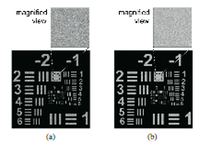
Reconstructed images: (a) Original and (b) Proposed method.
A speckle-reduction method with random locations of sparse object points is proposed for image quality improvement based on a time-multiplexing approach in holographic reconstruction. The object points of a reconstructed image are divided into groups of sparse object points. Pixel separation of the periodic location, in general, is used for the sparse object points. However, an unwanted periodic fringe pattern is caused, and it dominantly degrades the reconstructed image quality. The proposed random pixel separation enables the reconstructed image quality to improve more effectively. The numerical simulation and the optical experiment are presented to confirm the performance of the proposed method.
Reference
- Yutaka Mori, Takahiko Fukuoka, and Takanori Nomura, "Speckle reduction in holographic projection by random pixel separation with time multiplexing,” Appl. Opt. 53, 8182-8188 (2014).